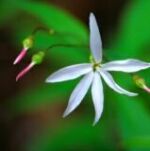| Common Name: |
Bowman's Root |
| Other Names: |
Indian Physic, American ipecac |
| Botanical Name: |
Gillenia trifoliata syn Porteranthus trifoliatus. |
| Genus: |
Gillenia |
| Family: |
Rosaceae |
| Native Location: |
Eastern N America |
| Cultivation: |
Moist, well-drained, neutral to acid soil in partial shade. |
| Propagation: |
By seed sown when ripe; by division in autumn or spring. |
| Harvest: |
Roots are lifted in early autumn and stripped of bark, which is dried for use in decoctions and powders. |
| Height: |
1-1.2m (3-4ft) |
| Width: |
60cm (24in) |
| Hardiness: |
Z4-8 |
| Parts Used: |
Root bark. |
| Properties: |
An emetic herb, similar in effects to Cephaelis ipecacuanha (See, ipecac). It also has purgative and expectorant effects. Small doses act as a stimulant. |
| Medicinal Uses: |
Internally, in small doses, for feverish illnesses, chronic diarrhea, constipation, and bronchial and asthmatic complaints. |
| Bibliography: |
Encylopedia of Herbs by Deni Brown Copyright ©: 1995, 2001 Dorling Kindersley Limited pg 224
|

